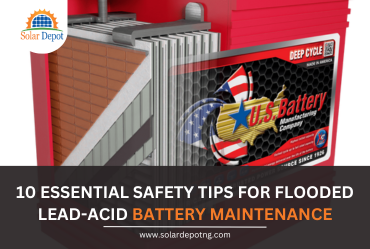10 Essential Safety Tips for Flooded Lead-Acid Battery Maintenance
Flooded lead-acid batteries are commonly used in various applications, from automotive to renewable energy systems. While performing maintenance on these batteries is relatively straightforward, safety precautions are paramount to avoid accidents and injuries. In this guide, we'll outline 10 essential safety tips for flooded lead-acid battery maintenance;
Wear Protective Gear: Always wear protective eyewear and gloves when handling lead-acid batteries. The electrolyte in these batteries contains sulfuric acid, which can cause severe burns if it comes into contact with the skin or eyes. Promptly rinse any exposed areas with water and seek medical attention if necessary.
Prevent Sparks or Flames: Avoid sources of sparks or flames when working near batteries, as hydrogen and oxygen gases produced during charging can ignite and cause explosions. Maintain a spark-free environment to minimize the risk of accidents.
Use Insulated Tools and Remove Jewelry: Use insulated tools and remove metal jewelry before handling batteries to prevent accidental arcing and burns. Insulated tools minimize the risk of electrical hazards, while jewelry can conduct electricity and become hot when in contact with battery terminals.
Handle Batteries with Caution: Lead-acid batteries are heavy, and injuries often occur when lifting or moving them by hand. Use proper lifting techniques or battery carriers to avoid strain or accidents.
Keep Neutralizing Solution Handy: Prepare a baking soda and water solution to neutralize the spilled electrolyte quickly. Keep the solution nearby during maintenance tasks to promptly clean up any spills and prevent corrosion.
Use Compatible Chargers: Ensure that you use the correct type of charger recommended by the battery manufacturer. Follow charging instructions carefully to maximize battery life and performance while minimizing the risk of overcharging or undercharging.
Maintain Proper Electrolyte Levels: Use distilled or deionized water to maintain electrolyte levels in flooded lead-acid batteries. Avoid overfilling or underfilling battery cells to prevent damage and ensure optimal performance.
Store Batteries Safely: Store batteries in a cool, dry, and well-ventilated area away from heat sources, flames, and sparks. Mark the storage area with appropriate warning signs to prevent accidents.
Secure Vent Caps: Ensure that battery vent caps are securely seated to prevent electrolyte spills and exposure to explosive gases. Regularly inspect and tighten vent caps as needed to maintain battery integrity.
Designate a Maintenance Area: Establish a dedicated area for battery maintenance equipped with insulated tools, protective gear, wash stations, and proper ventilation. Organize the workspace to minimize hazards and facilitate safe handling practices.
By following these 10 safety tips, you can ensure safe and effective maintenance of flooded lead-acid batteries. Prioritize safety protocols to protect yourself and others from accidents and injuries during battery handling and maintenance.






